window Lancia Delta 2011 Owner handbook (in English)
[x] Cancel search | Manufacturer: LANCIA, Model Year: 2011, Model line: Delta, Model: Lancia Delta 2011Pages: 290, PDF Size: 8.36 MB
Page 150 of 290
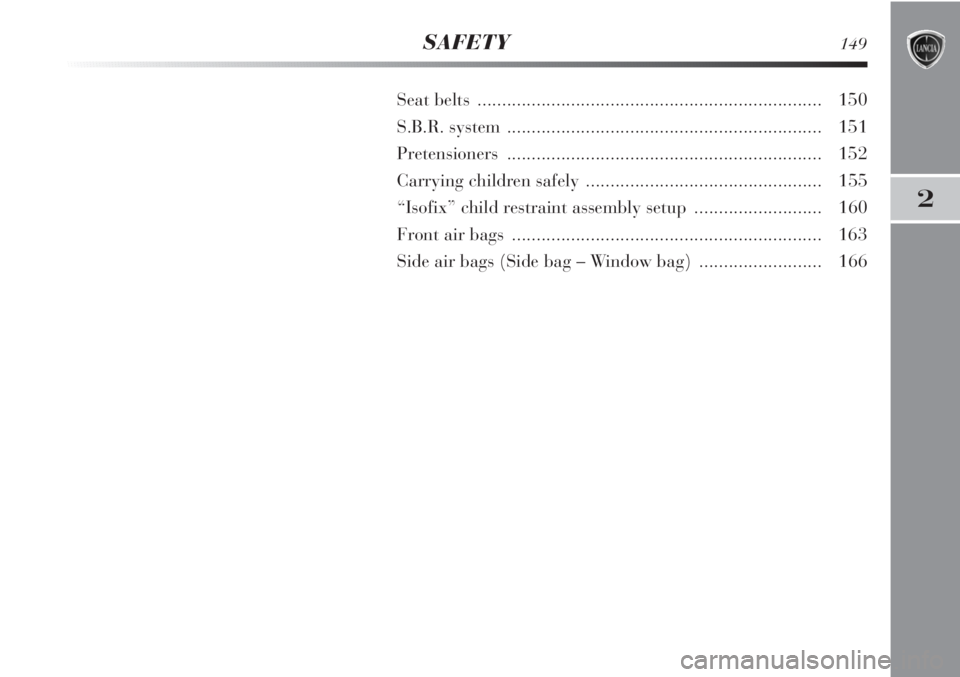
SAFETY149
2
Seat belts ...................................................................... 150
S.B.R. system ................................................................ 151
Pretensioners ................................................................ 152
Carrying children safely ................................................ 155
“Isofix” child restraint assembly setup .......................... 160
Front air bags ............................................................... 163
Side air bags (Side bag – Window bag) ......................... 166
Page 164 of 290

2
SAFETY163
FRONT AIR BAGS
The car is provided with front air bags for the driver and
the passenger, driver’s knee air bag (for versions/markets
where provided) and front side bags (side bags – window
bags).
The front air bags (driver, passenger driver’s knee bag)
protect the occupants of the front seats in the event of
moderate to serious front impacts by positioning the bag
between the occupant and the steering wheel or the dash-
board.
Therefore non-activation in other types of collisions (side
collisions, rear shunts, roll-overs, etc.) is not a system
malfunction.
An electronic control unit will make the bag inflate in the
event of a frontal impact.
The bag will inflate instantaneously placing itself be-
tween the front occupants body and the structures which
could cause injury. It will deflate immediately afterwards.
The front airbags (driver’s, passenger’s, driver’s knee air
bags) do not replace but rather complement the seat
belts, which you are always recommended to wear, as
specified by law in Europe and most non-European coun-
tries.
In the event of an impact, someone not wearing a seat belt
could move forward and come into contact with a bag
which is still in the opening phase. The protection offered
by the bag is reduced in such a case.The front air bags may not be activated in the following
situations:
❍front collisions against highly deformable objects not
affecting the front surface of the car (e.g. bumper col-
lision against guard rail, etc.);
❍car wedging under other vehicles or protective barri-
ers (e.g. trucks or guard rails);
they may not provide any additional protection compared
with seat belts, so their activation would be inappropri-
ate. Therefore, failure to come into action in the above
circumstances does not mean that the system is not work-
ing properly.
Do not apply stickers or other objects on the
steering wheel, on the dashboard in the pas-
senger side airbag area, on side upholstery
on roof and on the seats. Never put objects (e.g. mo-
bile phones) on the passenger’s side dashboard since
they could interfere with proper air bag inflation
and also cause serious injury to the passengers.
Page 167 of 290

166SAFETY
SIDE AIR BAGS
(Side bag – Window bag)
SIDE BAG fig. 10
It consists of an instantly-inflating bag housed in the front
seat backrest. It protects the chest and the pelvis of the
passengers in the event of side impacts of medium-high
severity.WINDOW BAG fig. 11
This is formed by two “curtain” window bags located be-
hind the side roof cover and are covered by special trim.
They are designed to protect the head of front and rear
passengers in the event of side collisions, thanks to the
wide cushion inflation surface.
IMPORTANT In the event of a side impact, the system
provides best protection if the passenger sits on the seat
in a correct position, thus allowing correct window bag
deployment.
fig. 10L0E0070mfig. 11L0E0071m
Page 168 of 290
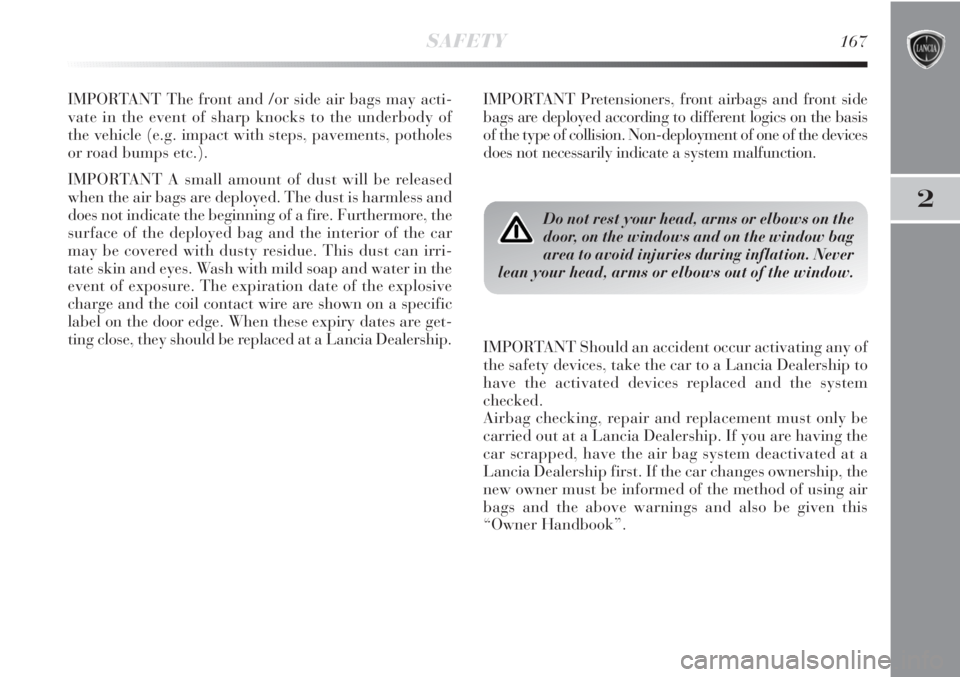
2
SAFETY167
IMPORTANT The front and /or side air bags may acti-
vate in the event of sharp knocks to the underbody of
the vehicle (e.g. impact with steps, pavements, potholes
or road bumps etc.).
IMPORTANT A small amount of dust will be released
when the air bags are deployed. The dust is harmless and
does not indicate the beginning of a fire. Furthermore, the
surface of the deployed bag and the interior of the car
may be covered with dusty residue. This dust can irri-
tate skin and eyes. Wash with mild soap and water in the
event of exposure. The expiration date of the explosive
charge and the coil contact wire are shown on a specific
label on the door edge. When these expiry dates are get-
ting close, they should be replaced at a Lancia Dealership.IMPORTANT Pretensioners, front airbags and front side
bags are deployed according to different logics on the basis
of the type of collision. Non-deployment of one of the devices
does not necessarily indicate a system malfunction.
Do not rest your head, arms or elbows on the
door, on the windows and on the window bag
area to avoid injuries during inflation. Never
lean your head, arms or elbows out of the window.
IMPORTANT Should an accident occur activating any of
the safety devices, take the car to a Lancia Dealership to
have the activated devices replaced and the system
checked.
Airbag checking, repair and replacement must only be
carried out at a Lancia Dealership. If you are having the
car scrapped, have the air bag system deactivated at a
Lancia Dealership first. If the car changes ownership, the
new owner must be informed of the method of using air
bags and the above warnings and also be given this
“Owner Handbook”.
Page 178 of 290
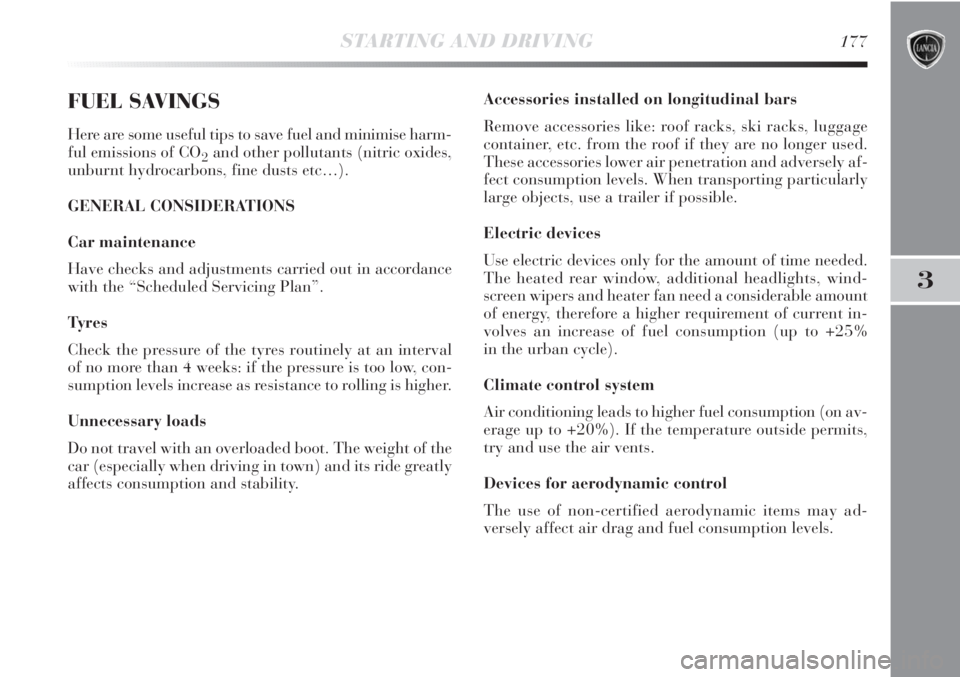
3
STARTING AND DRIVING177
FUEL SAVINGS
Here are some useful tips to save fuel and minimise harm-
ful emissions of CO
2and other pollutants (nitric oxides,
unburnt hydrocarbons, fine dusts etc…).
GENERAL CONSIDERATIONS
Car maintenance
Have checks and adjustments carried out in accordance
with the “Scheduled Servicing Plan”.
Ty r e s
Check the pressure of the tyres routinely at an interval
of no more than 4 weeks: if the pressure is too low, con-
sumption levels increase as resistance to rolling is higher.
Unnecessary loads
Do not travel with an overloaded boot. The weight of the
car (especially when driving in town) and its ride greatly
affects consumption and stability.Accessories installed on longitudinal bars
Remove accessories like: roof racks, ski racks, luggage
container, etc. from the roof if they are no longer used.
These accessories lower air penetration and adversely af-
fect consumption levels. When transporting particularly
large objects, use a trailer if possible.
Electric devices
Use electric devices only for the amount of time needed.
The heated rear window, additional headlights, wind-
screen wipers and heater fan need a considerable amount
of energy, therefore a higher requirement of current in-
volves an increase of fuel consumption (up to +25%
in the urban cycle).
Climate control system
Air conditioning leads to higher fuel consumption (on av-
erage up to +20%). If the temperature outside permits,
try and use the air vents.
Devices for aerodynamic control
The use of non-certified aerodynamic items may ad-
versely affect air drag and fuel consumption levels.
Page 182 of 290

3
STARTING AND DRIVING181
Keep your speed down when snow chains are
fitted. Do not exceed 50 km/h. Avoid pot-
holes, steps and pavements and also avoid
driving long distances on roads not covered with
snow in order to prevent damaging the car and the
roadbed.
SNOW CHAINS
The use of snow chains should be in compliance with lo-
cal regulations.
The snow chains may be applied only onto the front
wheel tyres (drive wheels).
Check the tension of the snow chains after the first few
metres have been driven.
IMPORTANT Snow chains cannot be fitted to the space-
saver spare wheel. So, if a front (drive) wheel is punc-
tured and chains are needed, a rear wheel should be fit-
ted to the front of the car and the space-saving spare
wheel should be fitted to the rear. This way with two nor-
mal drive wheels, snow chains can be fitted to them to
solve an emergency.
CAR INACTIVITY
If the car is to be left inactive for longer than a month,
the following precautions should be followed:
❍park the car in a covered, dry and, if possible, well-
ventilated place;
❍engage a gear;
❍check that the handbrake is not engaged;
❍disconnect the negative battery terminal (for versions
with Start&Stop system refer to the paragraph
“Start&Stop system” in chapter “1”);
❍clean and protect the painted parts of the vehicle with
protective wax;
❍clean and protect the shiny metal parts using special
compounds commercially available;
❍sprinkle talcum powder on the rubber windscreen and
rear window wiper blades and lift them off the glass;
❍open the windows slightly;
❍cover the car with a fabric or perforated plastic sheet.
Do not use sheets of non-perforated plastic as they
do not allow moisture on the car body to evaporate;
❍inflate tyres to a pressure of +0.5 bar above the nor-
mal specified pressure and check regularly;
❍do not drain the engine cooling system.
Page 218 of 290

IN AN EMERGENCY217
4
FUSE SUMMARY TABLE
F12
F12
F13
F13
F31
F33
F34
F35
F36
F37
F38
F39
F40
F417.5
15
7.5
15
5
20
20
5
20
7.5
10
10
30
7.538
38
38
38
38
38
38
38
38
38
38
38
38
38
USERS FUSE AMPS FIGURE
Right dipped beam headlight
Right dipped beam headlight (Xenon gas discharge bulb)
Left dipped beam headlight, headlight alignment corrector
Left dipped beam headlight (Xenon gas discharge bulb)
Climate control system fan relay coil, body computer
Left rear window winder
Right rear window winder
Reversing lights, engine compartment junction unit relay coils,
brake light pedal control (normally closed contact),
water in diesel sensor, air flow meter/control on clutch pedal
and brake servo pressure sensor (1.4 Turbo Multi Air versions)
Central locking system control unit, fuel flap,
dead lock, tailgate release
Third brake light, instrument panel, Adaptive Headlights Node
(1.4 Turbo Multi Air versions excluded), control unit on left hand
gas discharge headlight (1.4 Turbo Multi Air versions excluded)
Front rear and central roof light (for versions/markets where provided,
with electric sun roof), courtesy light on driver’s side and passenger’s side,
luggage compartment light and glove compartment light
Car radio and Radio navigator (1.4 Turbo Multi Air versions excluded),
Blue&Me™ Node, alarm siren, alarm system on roof light,
climate control unit, tyre pressure monitoring system control unit,
diagnosis socket connector, rear roof lights, voltage
stabiliser (1.4 Turbo Multi Air versions without HI-FI option)
Heated rear window
Electric door mirror demisters, demisters on windscreen jets
Page 219 of 290
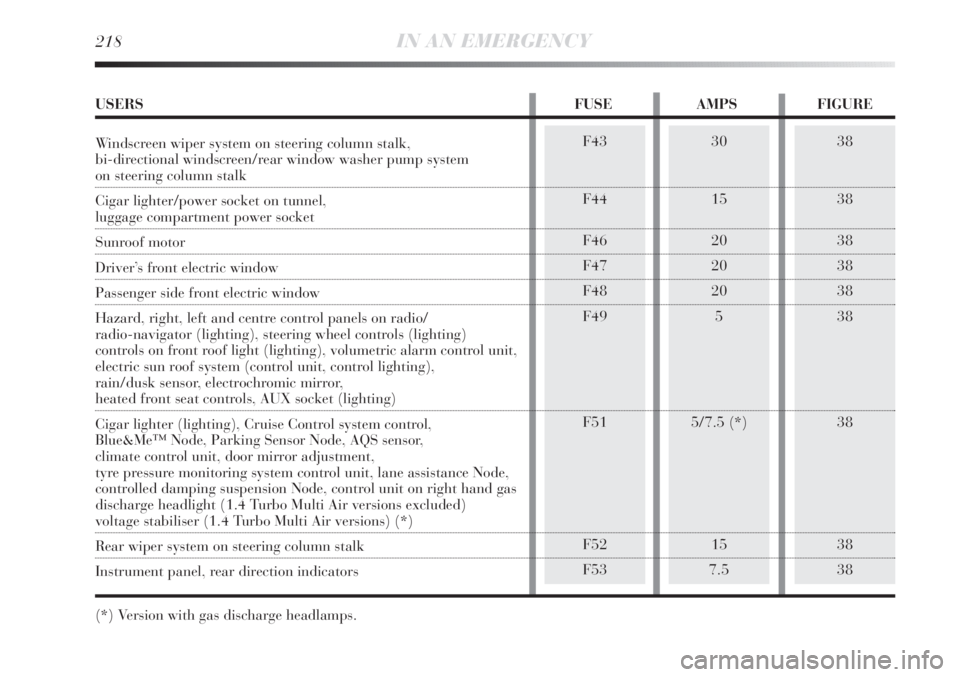
218IN AN EMERGENCY
38
38
38
38
38
38
38
38
38F43
F44
F46
F47
F48
F49
F51
F52
F5330
15
20
20
20
5
5/7.5 (*)
15
7.5
USERS FUSE AMPS FIGURE
Windscreen wiper system on steering column stalk,
bi-directional windscreen/rear window washer pump system
on steering column stalk
Cigar lighter/power socket on tunnel,
luggage compartment power socket
Sunroof motor
Driver’s front electric window
Passenger side front electric window
Hazard, right, left and centre control panels on radio/
radio-navigator (lighting), steering wheel controls (lighting)
controls on front roof light (lighting), volumetric alarm control unit,
electric sun roof system (control unit, control lighting),
rain/dusk sensor, electrochromic mirror,
heated front seat controls, AUX socket (lighting)
Cigar lighter (lighting), Cruise Control system control,
Blue&Me™ Node, Parking Sensor Node, AQS sensor,
climate control unit, door mirror adjustment,
tyre pressure monitoring system control unit, lane assistance Node,
controlled damping suspension Node, control unit on right hand gas
discharge headlight (1.4 Turbo Multi Air versions excluded)
voltage stabiliser (1.4 Turbo Multi Air versions) (*)
Rear wiper system on steering column stalk
Instrument panel, rear direction indicators
(*) Version with gas discharge headlamps.
Page 224 of 290
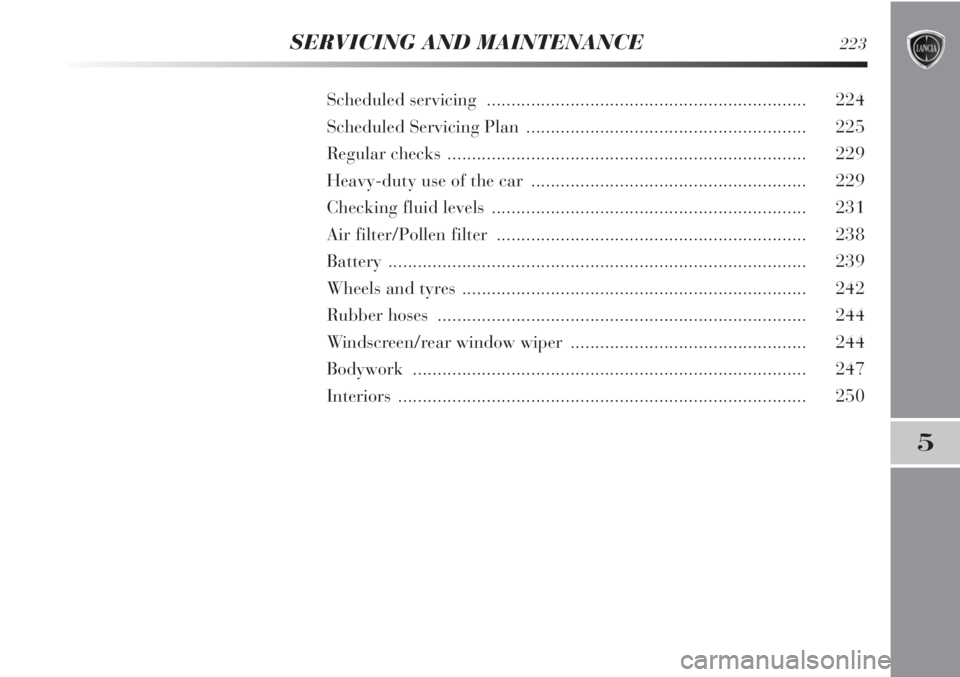
5
SERVICING AND MAINTENANCE223
Scheduled servicing ................................................................. 224
Scheduled Servicing Plan ......................................................... 225
Regular checks ......................................................................... 229
Heavy-duty use of the car ........................................................ 229
Checking fluid levels ................................................................ 231
Air filter/Pollen filter ............................................................... 238
Battery ..................................................................................... 239
Wheels and tyres ...................................................................... 242
Rubber hoses ........................................................................... 244
Windscreen/rear window wiper ................................................ 244
Bodywork ................................................................................ 247
Interiors ................................................................................... 250
Page 226 of 290
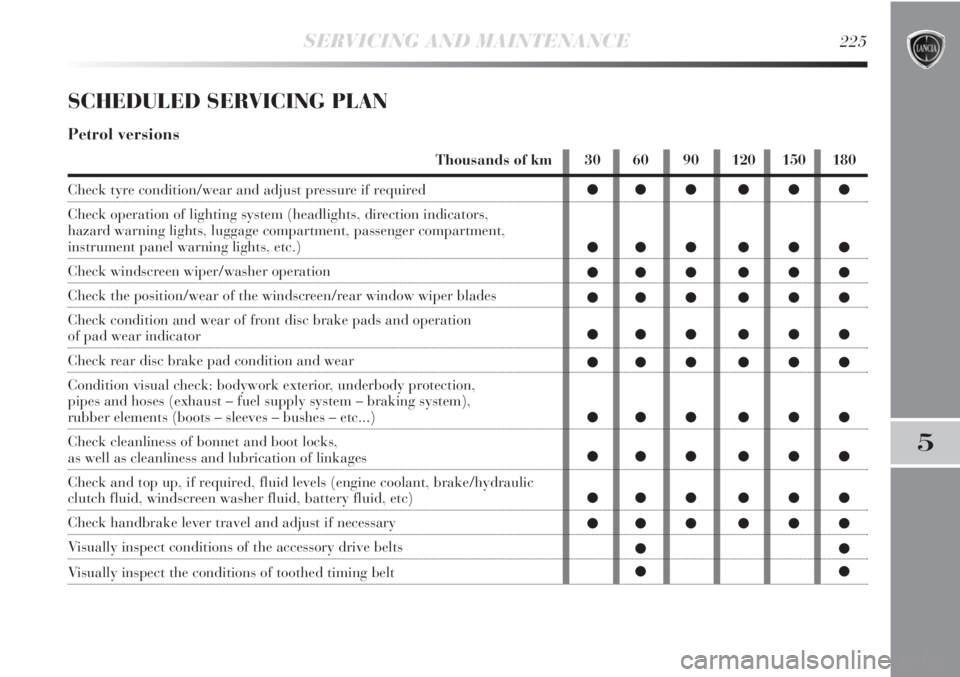
30 60 90 120 150 180
●●● ●●●
●●● ●●●
●●● ●●●
●●● ●●●
●●● ●●●
●●● ●●●
●●● ●●●
●●● ●●●
●●● ●●●
●●● ●●●
●●
●●
SERVICING AND MAINTENANCE225
5
SCHEDULED SERVICING PLAN
Petrol versions
Thousands of km
Check tyre condition/wear and adjust pressure if required
Check operation of lighting system (headlights, direction indicators,
hazard warning lights, luggage compartment, passenger compartment,
instrument panel warning lights, etc.)
Check windscreen wiper/washer operation
Check the position/wear of the windscreen/rear window wiper blades
Check condition and wear of front disc brake pads and operation
of pad wear indicator
Check rear disc brake pad condition and wear
Condition visual check: bodywork exterior, underbody protection,
pipes and hoses (exhaust – fuel supply system – braking system),
rubber elements (boots – sleeves – bushes – etc...)
Check cleanliness of bonnet and boot locks,
as well as cleanliness and lubrication of linkages
Check and top up, if required, fluid levels (engine coolant, brake/hydraulic
clutch fluid, windscreen washer fluid, battery fluid, etc)
Check handbrake lever travel and adjust if necessary
Visually inspect conditions of the accessory drive belts
Visually inspect the conditions of toothed timing belt